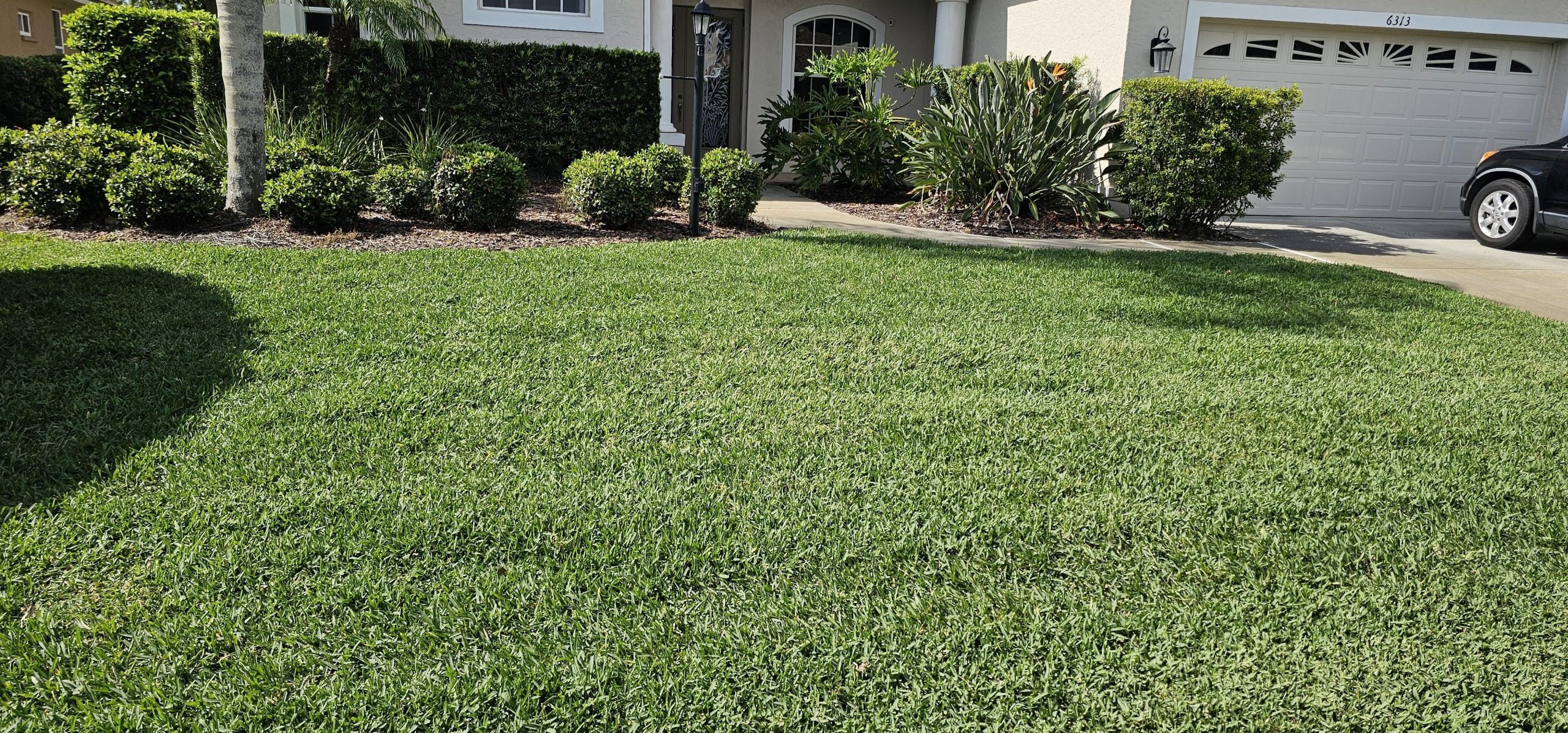CitraBlue® St. Augustine Sod: The Ultimate Lawn Guide
If you’re aiming for a vibrant, low-maintenance lawn that thrives in warm climates, CitraBlue® St. Augustine is your go-to choice. Developed by the University of Florida’s turfgrass breeding program with the Turfgrass Producers of Florida, Inc. (TPF) and released in 2018 after a decade of research starting in 2006, this sod is engineered to tackle disease, shade, and drought challenges head-on. Below, dive into the details of its stunning color, growth patterns, pest and disease resistance, and more—perfect for Florida’s humid conditions or similar regions.
Eye-Catching Color and Aesthetic Appeal
CitraBlue’s deep blue-green hue sets it apart, offering a darker, richer tone than most St. Augustine varieties for a lush, carpet-like lawn that boosts curb appeal.
- Color retention: Holds its bluish tint through dry fall conditions, resisting yellowing or browning better than greener varieties like Floratam.
- Spring recovery: Quickly regains vibrancy with medium-width, slightly sheened blades, enhanced by proper fertilization.
- Comparison: Outshines Floratam’s standard green and Palmetto’s lighter blue, often described as “jewel-like,” reducing the need for color additives.
Pro Tip: Fertilize with a balanced, slow-release N-P-K mix to maintain that stunning blue-green sheen year-round.
Growth Patterns and Habits
CitraBlue grows via vigorous stolons (above-ground runners), forming a dense, horizontal mat that’s more carpet-like than upright, requiring less mowing than traditional St. Augustines.
- Blade characteristics: Wider blades with a medium texture, mowable at 2.5–3.5 inches (or lower without scalping) for a plush look.
- Spreading speed: Rapidly fills bare patches, ideal for new lawns or repairs, but can build thatch (>0.5 inches) if unmanaged.
- Vertical growth: Minimal, needing mowing every 1–2 weeks in peak summer at 1–3 inches, ideally taller for weed suppression.
- Root system: Deep, fibrous roots support vigor, encouraged by infrequent, deep watering.
Fun Fact: CitraBlue produces little viable seed, spreading only by stolons, so it won’t invade non-target areas!
Shade Tolerance
A standout feature, CitraBlue’s exceptional shade tolerance makes it perfect for low-light yards, outperforming many St. Augustines like Floratam.
- Light needs: Thrives with 4–5 hours of direct sun or filtered light, maintaining density under trees or in partial shade.
- Shade performance: Stays lush and blue-green with minimal thinning, even in moist, shady spots prone to disease.
- Comparisons: Matches Palmetto’s shade tolerance but surpasses Floratam; excels in Florida’s dappled oak shade.
Drought Tolerance
CitraBlue is highly drought-tolerant, wilting less and recovering faster than many peers, thanks to its deep roots and efficient water use.
- Water needs: About 1 inch per week via deep, infrequent watering; survives on less during restrictions, going dormant but rebounding quickly.
- Stress response: Retains color longer than Floratam, Palmetto, or Raleigh, with minimal off-coloring in severe drought.
- Perks: Reduces water bills and supports sustainable landscaping in arid or regulated areas.
Disease Resistance
Bred for superior disease resistance, CitraBlue fends off common turf killers, reducing fungicide needs by over 50% compared to susceptible varieties.
Fungal Diseases
- Gray Leaf Spot (Magnaporthe oryzae): Highly resistant, with minimal severity and quick recovery compared to Floratam.
- Large Patch (Rhizoctonia solani): Matches Floratam’s resistance; low incidence in humid conditions.
- Take-All Root Rot (Gaeumannomyces graminis var. tritici): Outperforms Floratam and Palmetto, maintaining turf quality.
- General fungi: Good tolerance, especially in moist shade; standard fungicides work fast if needed.
Viral Diseases
- Lethal Viral Necrosis (Sugarcane Mosaic Virus): Highly resistant, often asymptomatic, unlike Floratam, which can be devastated.
Did You Know? CitraBlue’s resistance to Lethal Viral Necrosis makes it a top choice in Florida amid the LVN epidemic.
Pest Resistance
While not specifically bred for insects, CitraBlue’s density and vigor help it recover from pest damage better than sparser grasses.
- Chinch bugs: Susceptible; monitor and treat with insecticides, but quick recovery minimizes damage.
- Sod webworms, armyworms, mole crickets: Standard vulnerability; dense turf withstands feeding better.
- St. Augustine Decline (SAD) virus: Excellent resistance, avoiding yellowing common in older grasses.
Tip: Use integrated pest management (e.g., scouting, beneficial nematodes) to keep interventions minimal.
Weed Resistance
CitraBlue’s dense growth naturally suppresses weeds by crowding them out and shading the soil.
- Mechanism: Aggressive stolons cover bare spots; taller mowing (over 1 inch) deters crabgrass and others.
- Thatch: Tighter thatch blocks weed seed germination.
- Comparisons: Outperforms Floratam; similar to low-mow Scotts ProVista but with shade benefits.
Maintenance Requirements
Designed for low-maintenance lifestyles, CitraBlue thrives with basic care, saving time and resources.
| Aspect | Recommendations | Tips for Success |
|---|---|---|
| Mowing | 2.5–3.5 inches; weekly in summer, every 1–2 weeks otherwise. Leave clippings for natural N. | Avoid scalping; use sharp blades to reduce disease entry. |
| Watering | 1 inch/week, deep & infrequent (1–2 sessions). | Early morning watering minimizes evaporation/fungus; adjust for rain. |
| Fertilizing | 3–4 apps/season with slow-release N-P-K (lower N than Floratam). Spring/fall focus. | Soil test first; avoid over-fertilizing to prevent pests/disease. |
| Thatch Management | Annual aeration or vertical mowing if >0.5 inches. | Core aerate in late spring for better water/disease resistance. |
| Pest/Disease Control | Scout monthly; use IPM/fungicides as needed. | Morning watering, good airflow deter fungi. |
Scientific Backing and Comparisons
University of Florida trials confirm CitraBlue’s edge:
- Disease trials: 2020 UF study showed superior gray leaf spot and take-all resistance vs. Floratam/Palmetto.
- Shade/drought: Excels in low-light/dry tests, outperforming Floratam.
- Vs. others: Darker than Palmetto, shadier than Floratam, less thatchy than Seville; a top pick for LVN-hit areas.
As of 2025, ongoing research continues to validate CitraBlue’s long-term performance in diverse landscapes.
Get Growing!
CitraBlue isn’t just sod—it’s a resilient, eye-catching solution for an effortless lawn. Source from certified growers for best results and start enjoying your vibrant, low-maintenance yard today! Got questions? Share them below! #CitraBlueFacts #TurfNerd
Content compiled from University of Florida/IFAS research and turfgrass industry insights, 2025.


